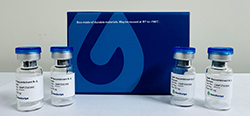HRP-Protein L
Protein L is a cell surface protein expressed by Peptostreptoccocus magnus, that binds to the variable light chains (kappa chains) of immunoglobulins without interfering with antigen binding. In contrast to IgG-binding proteins such as protein A and protein G, protein L can be used for the detection and purification of mammalian kappa light chain antibodies of all classes. HRP-Protein L is produced by covalently linking HRP to protein L. The complex can be used in immuno-detection such as immunoblotting (western or dot blot), ELISA, and immunohistochemistry.
| M00098 | |
|
|
|
| ¥950 | |
|
|
|
|
|
|
| 联系我们 | |

































